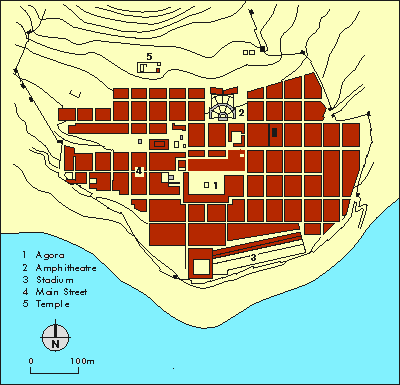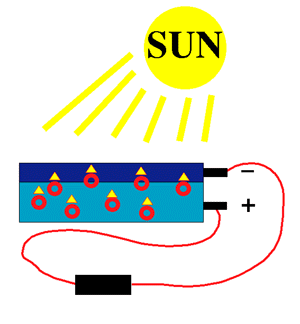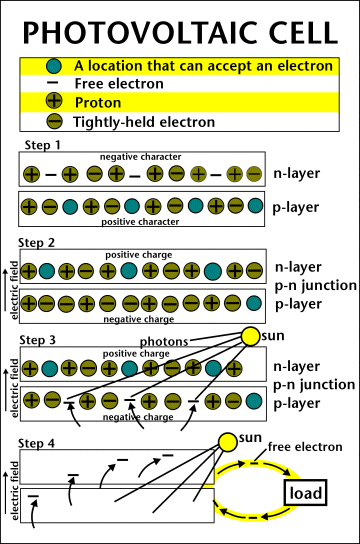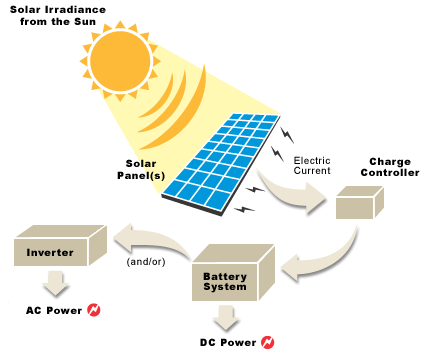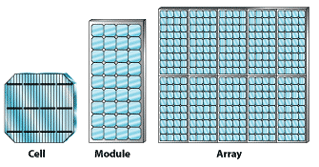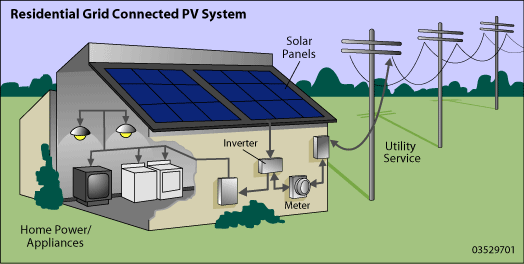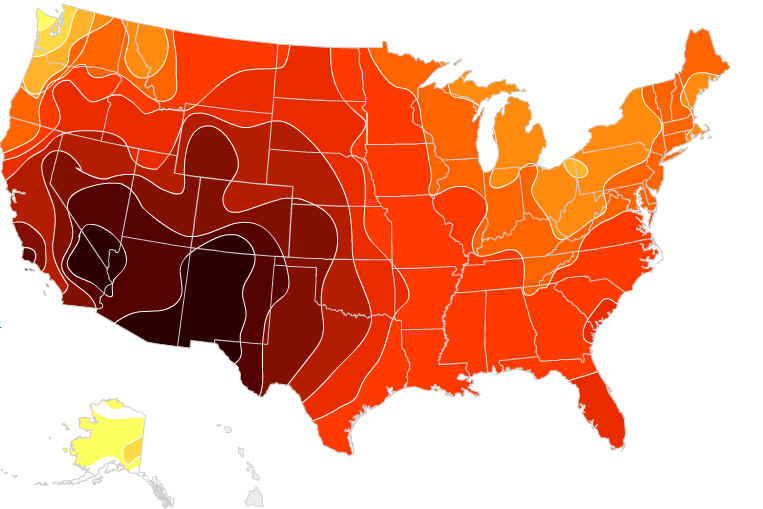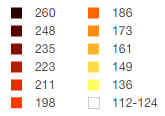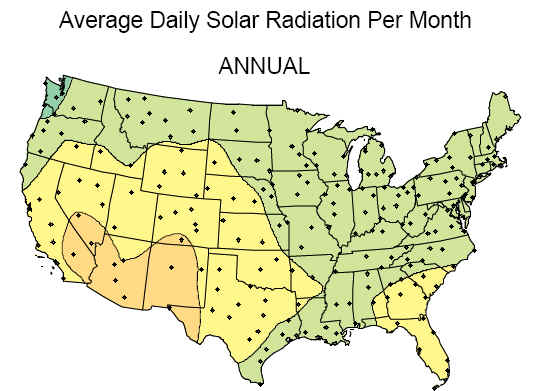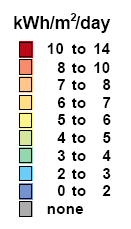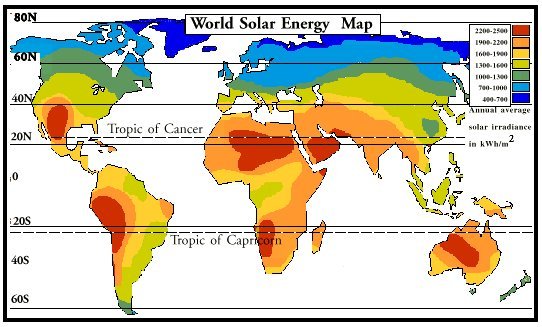
|
||||||||||||
|
|
|
Solar Energy
Solar energy technologies produce electricity from the energy of the sun. Small solar energy systems can provide electricity for homes, businesses, and remote power needs. Larger solar energy systems provide more electricity for contribution to the electric power system. How Does Solar Power Work?
We have always used the energy of the sun as far back as humans have existed on this planet. As far back as 5,000 years ago, people "worshipped" the sun. Ra, the sun-god, who was considered the first king of Egypt. In Mesopotamia, the sun-god Shamash was a major deity and was equated with justice. In Greece there were two sun deities, Apollo and Helios. The influence of the sun also appears in other religions - Zoroastrianism, Mithraism, Roman religion, Hinduism, Buddhism, the Druids of England, the Aztecs of Mexico, the Incas of Peru, and many Native American tribes.
Solar energy technologies harness the sun's energy for practical ends. These technologies date from the time of the early Greeks, Native Americans and Chinese, who warmed their buildings by orienting them toward the sun.
Cliff dwelling at Mesa Verde
Through most of history people considered the power of the sun when designing buildings. After the industrial revolution the practice of utilizing the sun was abandoned.
Past societies such as the Greek, Roman, Native American, Celtic all revered the sun and put its thermal - or heat - energy to work. Ancient cities were positioned to use the sun for it's warmth in the winter, and to be shaded from the heat in the summer. Native Americans developed and refined many building forms and construction methods that we can learn from today.
The Anasazi of the southwest created houses that through their design stayed warm in the winter and yet cool in their hot desert summers. At the ancient Indian sites of Mesa Verde and Pueblo Bonito,"pretty village" in Spanish, the ruins reveal houses ingeniously laid out to maximize their solar energy gain by following the cycles and angles of the sun.
The Ancient Romans and Greeks both had their own "energy crisis" in the b.c. time period. They used all of the wood surrounding their cities and did not plan ahead by planting more trees. They had to get wood from far away sources. The ancient Greeks planned whole cities in Greece and Asia Minor such as Priene, to allow every homeowner access to sunlight during winter to warm their homes. By running the streets in a checkerboard pattern running east-west and north-south pattern every home could face south, permitting the winter sun to flow into the house throughout the day.
Map of Priene
Roman bath houses in the first to fourth centuries A.D. had large south-facing windows to let in the sun's warmth.
The Baths of Caracalla
The Roman Empire had solar access laws, and the Doctrine of Ancient Lights protected landowners' rights to light in nineteenth-century Britain. Several dozen U.S. communities adopted solar access regulations in the 1970s and early 1980s in response to the energy crisis.
Solar energy—power from the sun—is free and inexhaustible. This vast, clean energy resource represents a viable alternative to the fossil fuels that currently pollute our air and water, threaten our public health, and contribute to global warming.
Solar Energy is a clean environmentally friendly source of power.
Solar Power on Earth
Photovoltaic energy is the conversion of sunlight into electricity through a photovoltaic (PVs) cell, commonly called a solar cell. A photovoltaic cell is a nonmechanical device usually made from silicon alloys. Sunlight is composed
of photons, or particles of solar energy. These photons contain various
amounts of energy corresponding to the different wavelengths of the solar
spectrum. When photons strike a photovoltaic cell, they may be reflected,
pass right through, or be absorbed. Only the absorbed photons provide
energy to generate electricity. When enough sunlight (energy) is absorbed
by the material (a semiconductor), electrons are dislodged from the material's
atoms. Special treatment of the material surface during manufacturing
makes the front surface of the cell more receptive to free electrons, so the
electrons naturally migrate to the surface.
When the electrons leave their position, holes are formed. When many electrons, each carrying a negative charge, travel toward the front surface of the cell, the resulting imbalance of charge between the cell's front and back surfaces creates a voltage potential like the negative and positive terminals of a battery. When the two surfaces are connected through an external load, electricity flows. The photovoltaic cell is the basic building block of a PV system. Individual cells can vary in size from about 1 cm (1/2 inch) to about 10 cm (4 inches) across. However, one cell only produces 1 or 2 watts, which isn't enough power for most applications. To increase power output, cells are electrically connected into a packaged weather-tight module. Modules can be further connected to form an array. The term array refers to the entire generating plant, whether it is made up of one or several thousand modules. As many modules as needed can be connected to form the array size (power output) needed. The performance of a photovoltaic array is dependent upon sunlight. Climate conditions (e.g., clouds, fog) have a significant effect on the amount of solar energy received by a PV array and, in turn, its performance. Most current technology photovoltaic modules are about 10 percent efficient in converting sunlight with further research being conducted to raise this efficiency to 20 percent.
Solar Power 101Video - how does sunlight turn into electricity The pv cell was discovered in 1954 by Bell Telephone researchers examining the sensitivity of a properly prepared silicon wafer to sunlight. Beginning in the late 1950s, pvs were used to power U.S. space satellites. The success of PVs in space generated commercial applications for pv technology. The simplest photovoltaic systems power many of the small calculators and wrist watches used everyday. More complicated systems provide electricity to pump water, power communications equipment, and even provide electricity to our homes.
Photovoltaic conversion is useful for several reasons. Conversion from sunlight to electricity is direct, so that bulky mechanical generator systems are unnecessary. The modular characteristic of photovoltaic energy allows arrays to be installed quickly and in any size required or allowed. Also, the environmental impact of a photovoltaic system is minimal, requiring no water for system cooling and generating no by-products. Photovoltaic cells, like batteries, generate direct current (DC) which is generally used for small loads (electronic equipment). When DC from photovoltaic cells is used for commercial applications or sold to electric utilities using the electric grid, it must be converted to alternating current (AC) using inverters, solid state devices that convert DC power to AC. Historically, pvs have been used at remote sites to provide electricity. However, a market for distributed generation from PVs may be developing with the unbundling of transmission and distribution costs due to electric deregulation. The siting of numerous small-scale generators in electric distribution feeders could improve the economics and reliability of the distribution system. Photovoltaic Cells
Photovoltaic (or PV) systems convert light energy into electricity. The term "photo" is a stem from the Greek "phos," which means "light." "Volt" is named for Alessandro Volta (1745-1827), a pioneer in the study of electricity.
"Photo-voltaics," then, could literally mean "light-electricity." Most commonly known as "solar cells," PV systems are already an important part of our lives. The simplest systems power many of the small calculators and wrist watches we use every day.
Photovoltaic Cell Photovoltaics are one of the fastest growing solar energy technologies. Photovoltaic devices, commonly called solar cells or modules, use semiconductor material to directly convert sunlight into electricity. Solar cells have no moving parts—power is produced when sunlight strikes the semiconductor material and creates an electric current.
Photovoltaic Panels Photovoltaic (PV) cells are made primarily of silicon, the second most abundant element in the earth's crust, and the same semiconductor material used for computers. When the silicon is combined with one or more other materials, it exhibits unique electrical properties in the presence of sunlight. Electrons are excited by the light and move through the silicon. This is known as the photovoltaic effect and results in direct current (DC) electricity. PV modules have no moving parts, are virtually maintenance-free, and have a working life of 20 - 30 years. High Reliability PV cells were originally developed for use in space, where repair is extremely expensive, if not impossible. PV still powers nearly every satellite circling the earth because it operates reliably for long periods of time with virtually no maintenance. Low Operating Costs PV cells use the energy from sunlight to produce electricity–the fuel is free. With no moving parts, the cells require little upkeep. These low-maintenance, cost-effective PV systems are ideal for supplying power to communications stations on mountain tops, navigational buoys at sea, or homes far from utility power lines. Environment Because they burn no fuel and have no moving parts, PV systems are clean and silent. This is especially important where the main alternatives for obtaining power and light are from diesel genertors and kerosene lanterns. As we become more aware of "greenhouse gases" and their detrimental effects on our planet, clean energy alternatives like PV become more important than ever. The three basic types of solar
cells made from silicon are single-crystal, polycrystalline, and amorphous.
How Small Solar Electric Systems Work
Solar electric systems, also known as photovoltaic (PV) systems, convert sunlight into electricity. Solar cells—the basic building blocks of a PV system—consist of semiconductor materials. When sunlight is absorbed by these materials, the solar energy knocks electrons loose from their atoms. This phenomenon is called the "photoelectric effect." These free electrons then travel into a circuit built into the solar cell to form electrical current. Only sunlight of certain wavelengths will work efficiently to create electricity. PV systems can still produce electricity on cloudy days, but not as much as on a sunny day. The basic PV or solar cell typically produces only a small amount of power. To produce more power, solar cells (about 40) can be interconnected to form panels or modules. PV modules range in output from 10 to 300 watts. If more power is needed, several modules can be installed on a building or at ground-level in a rack to form a PV array. About 10–20 PV arrays can provide enough power for a household. PV arrays can be mounted at a fixed angle facing south, or they can be mounted on a tracking device that follows the sun, allowing them to capture the most sunlight over the course of a day. Because of their modularity, PV systems can be designed to meet any electrical requirement, no matter how large or how small. You also can connect them to an electric distribution system (grid-connected), or they can stand alone (off-grid).
PHOTOVOLTAIC HISTORY
Passive Solar Energy Passive solar energy systems require no energy to operate and are an intrinsic part of the home design. Passive systems add little additional cost, operate with almost no supervision and require little or no maintenance. The basic elements of all passive systems are south-facing windows and internal thermal mass. Solar heating is simply sunlight entering the house that is absorbed and converted into heat energy which is later released inside the house as it cools. A passive solar home is one where the design and construction of the home itself is made to keep the house naturally warm in the winter using the sun's energy. The design should also keep the house naturally cool during the summer
The sun is a very intense source of energy. When designed properly, a passive solar home can experience heating costs that are 80% to 95% lower than for the average home. Air conditioning costs can also be reduced to a minimal level. The basic idea of passive solar home design is to invite sunlight into the house during the winter, and once it is inside the home, to hold it in and store it until nighttime. Conversely, the sun needs to be kept out during the summer.
The Solar Resource
Solar Power Capacity In kWh/square foot per year
When sunlight reaches the Earth, it is distributed unevenly in different regions. Not surprisingly, the areas near the equator receive more solar radiation than anywhere else on Earth.
The solar irradiance figures indicate the average annual energy available per square miter
Concentrating Solar PowerMany power plants today use fossil fuels as a heat source to boil water. The steam from the boiling water spins a large turbine, which drives a generator to produce electricity. However, a new generation of power plants with concentrating solar power systems uses the sun as a heat source. The three main types of concentrating solar power systems are: linear concentrator, dish/engine, and power tower systems. Linear concentrator systems collect the sun's energy using long rectangular, curved (U-shaped) mirrors. The mirrors are tilted toward the sun, focusing sunlight on tubes (or receivers) that run the length of the mirrors. The reflected sunlight heats a fluid flowing through the tubes. The hot fluid then is used to boil water in a conventional steam-turbine generator to produce electricity. There are two major types of linear concentrator systems: parabolic trough systems, where receiver tubes are positioned along the focal line of each parabolic mirror; and linear Fresnel reflector systems, where one receiver tube is positioned above several mirrors to allow the mirrors greater mobility in tracking the sun.
credit: NOAA, U.S. DOE, American Wind Energy Association, Bureau of Land Management, Sandia National Labooratory |

